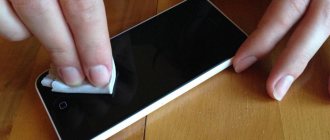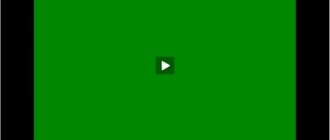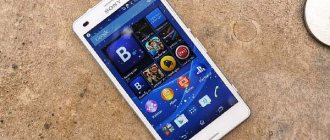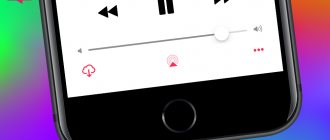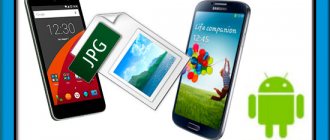Gluing protective glass onto a smartphone screen is a science. Many people do not risk carrying out this procedure on their own, and resort to the help of “specially trained people” who work in digital device sales stores. This instruction reveals not only the gluing procedure itself, but also some subtleties that manufacturers of such products do not always talk about, but are known to those who make money from this simple service.
How to properly stick protective glass on a smartphone
How to remove air bubbles from under protective glass: tips
- It is better to carry out all manipulations in a room with a limited amount of textiles (in the bathroom, in the kitchen).
- Bubbles that appear after gluing are removed by smoothing the surface of the protective glass with a flat object (for example, a credit card).
- If air bubbles still remain, it is better to repeat the glass gluing procedure. But before this, the screen of the gadget must be wiped with a special napkin that comes with a protective coating.
- Micro-debris from the protective glass is also removed with this napkin. If a special napkin is not available, a computer napkin is used.
- When gluing the protective glass, it is better to hold the device with your left hand. Use your thumb to hold the edge of the protective surface.
- Stick carefully. Make sure that no air gets under the protective coating and that the integrity of the protective accessory is not compromised.
- If air bubbles remain under the glass, then you need to lift it by the edge and then carefully lower it so that no air gets in.
Now you don’t have to look for information on how to glue protective glass on a smartphone, iPhone 5, 5S, 6, 6S, 7, Xiaomi, because we have collected all the answers in one article.
Preparation of the workplace
This advice seems absurd to many. Before gluing the protective glass, you need to wet clean the room where the work will be carried out. This is necessary to remove dust from the room. All electrical appliances attract the smallest dirt, and smartphones are no exception. This complicates the application of the protective coating. Due to the settling of tiny dust particles, invisible to the eye, animal hair creates air bubbles.
Before gluing the protective glass, we wet clean the room
If for some reason there is no time to clean, then at least ventilate the room. The bathroom or kitchen, where there is the least dust, is most suitable for gluing.
Despite the possibility of following the previous recommendation, be sure to wipe the table on which all work will be carried out with a damp cloth. It is advisable to moisten a cloth with water and detergent or antistatic agent. Be sure to wash your hands with soap and wear thin medical gloves.
Varieties
Protective coatings for tablets come in different varieties. Time does not stand still, manufacturing technologies vary. They differ in strength, shape and degree of attachment.
2D
They are rectangular in shape and cover only the front surface of the screen. There remains a small gap of 1 mm wide at the edges. Due to the invention, more durable options are practically not produced.
Colored
These are coatings that completely imitate the surface of the screen. There are holes for the speaker and camera on the top.
2.5D
The straight glass has cutouts for the tablet's speakers and front camera, and the edges are rounded. Not suitable for all models, as there are sensor systems curved at the edges. Protective coatings may bulge slightly, allowing air bubbles to get inside.
3D
Suitable for modern gadget models that have a curved screen. The design fits tightly to the sensor, completely follows all the curves, and is practically invisible on the tablet. The coating does not allow air bubbles to pass through and does not leave streaks. Reliably protects the screen from shocks and falls.
See also
How to properly plant an item made from various materials, step-by-step instructions and recommendations
4D
They have a dense structure, fit perfectly on the surface of the screen, and follow all curves. Dense material is used for production. The coating does not affect the operation of the sensor; it is practically invisible. Performs its function for many years.
Interesting information! Safety glass can withstand a hammer blow.
Common Mistakes
The biggest mistake that many make is quick gluing and, as a result, the appearance of air bubbles under the glass, as well as an uneven contour. To avoid this, you need to first try on the glass, and in the process of gluing it, press down the rest of the surface with your hands. The second mistake is poor screen degreasing. As a result, fingerprints, dust and dirt remain under the glass, which does not have the best effect on the operation of the touchpad.
See also
Technical characteristics and instructions for use of Dragon glue
Features of working with different models
When working with different models, the most important thing is to choose the right film size. There are several options for each model, with holes already made for the camera and microphone.
Iphone
There are a huge number of protective glasses for iPhone on sale. The first thing to do when gluing is to remove the cover. Many users forget about this. It is not recommended to purchase cases designed for other models.
Xiaomi
Protective glasses of suitable shapes are also available for sale for the Xiaomi model, but during gluing you should make sure in advance that the holes for the speaker, cameras and sensors completely match.
Meizu
Since the camera location differs in different Meizu models, you need to choose glass that is suitable for a specific model. To avoid mistakes, do a fitting before gluing.
Zte
High-quality glass for this model does not contain an adhesive layer and is fixed on the sides. Before applying it, you also need to degrease the display, but if necessary, the glass can be removed and later returned to its place.
Samsung
Glass for Samsung brand phones can be completely transparent or with a black rim around the edges. To re-glue the protection on such a phone, sometimes it is enough to simply remove the dirt.
Is it possible to stick it a second time?
If it was not possible to properly glue the protective coating the first time, or dust got on it, you can try to apply it again. This is possible if you follow the technique and degrease the screen well. The whole procedure takes two minutes, but in order for the glass to lie flat, there is no need to rush. The first thing you don’t need to do if the glass is crooked is to lift it with your fingernail or knife. Using tape, pry up the edge of the cover and tighten it, then the phone screen will not be damaged.
Solving common problems
Rarely does re-gluing occur easily and smoothly; more often, some problems arise. There may be abrasion of the glue in the corners, scratches on the glass and large accumulations of dirt and dust that cannot be cleaned.
A corner of the glass has come loose or is partially coming off
If a corner peels off, there is a small amount of glue left on it. It is not permissible to use PVA or any other glue, but you can glue the lagging corner by spreading the composition existing on the glass. You can use a special “liquid protection” product, which is applied to those places where the protective glass is not attached to the phone. To do this, use a small brush and smear the composition over the screen.
The glass fell off completely
If the glass falls off entirely and does not hold on, then it will most likely not be possible to solve the problem, and you will have to purchase a new protective coating. You can try to apply “liquid protection” and glue the film again, but if there is no adhesive left in it, it will not hold for long.
The glass does not stick to the edges
The most common question on the forums is “What to do if the glass does not glue at the edges.”
There are two ways to solve this problem:
- Use a ready-made special screen protector.
- Apply a small amount of vegetable oil or glycerin to the screen using a brush and coat all joints.
These are the simplest methods that anyone can use.
Reviews of protective glasses from Aliexpress
It's time to sum it up by making a final conclusion regarding glass from AliExpress. The process of sticking such an accessory is no different from installing protection from a store. At the same time, the cost of glass on Ali is several times lower.
This may be due to the relatively low quality of the ordered accessory. But the problem lies only in the presence or absence of an oleophobic coating. Often, glass developers refuse to spray and also do not pay serious attention to the degree of protection of the accessory.
Otherwise, the product from AliExpress is no different from the store version. And such an impressive markup is typical for all accessories, including covers. So you shouldn't be surprised by the price difference.
Be that as it may, it is important to get acquainted with the opinions of real buyers who decided to save money by buying glass on Ali. Were they satisfied with the purchase or did they regret not paying an extra 500 rubles for a branded accessory in the store?
Stepan
The glass arrived in 7 days, which I was very surprised by. Inside was the accessory itself and 2 pairs of napkins (one dry, the other wet). I pasted it quite easily, but I can’t say anything about the quality. Still, 50 rubles, while in the store they ask for 10 times more!
Elena
When I tried to track the parcel for a whole month, I no longer hoped that I would receive glass on my Samsung. Imagine my surprise when, 36 days after placing the order, I received an SMS from Russian Post. The glass was packed in polystyrene foam and there were 2 napkins inside. With their help, I easily wiped the screen and applied protection. Now I don’t understand at all why Euroset asks for 1000 rubles for the same quality.
Khabib
I'm probably not the first one who decided to order protective glass from AliExpress. And now, after a long wait, the accessory is in my hands. I was glad that the seller included napkins and a keychain. True, it didn’t work out to stick it properly. I just can’t get rid of the stains, and the seller doesn’t want to answer. I don't know whose fault it is, but I'm a little disappointed.
Valentina
This is not the first time I have ordered protective glass from Alika. But this time everything came in some kind of cobwebs. The feeling is not pleasant, to be honest. The glass was glued normally. But I don’t know how long it will be enough. The previous one had to be changed after the phone fell off the sofa. This time, I hope everything will work out.
4.3/5 — (24 votes)
How to re-glue correctly at home
If the glass was glued a few minutes or seconds ago, you can quickly tear it off and reapply it, then it will lie flat. However, if dust and hair are clogged, the surface will need to be cleaned before re-gluing.
What you will need
To update your phone's surface at home you will need:
- scotch;
- hair dryer;
- degreasing wipe.
This is enough to remove the protective coating and clean it of dirt.
Preparing the workplace
To prevent even more dust from sticking to the glass during work, you need to first prepare the room. If this is not done, all the dust will settle on the screen and the film will become covered with bubbles.
It is necessary to wash the floors in the room where the glass will be re-glued, and also spray the air with a spray bottle so that the dust settles.
Even a small amount of dust getting under the glass can ruin its appearance and create unevenness.
See also
How to properly glue thermal stickers onto clothes with your own hands, the best methods of application
How to glue it correctly
The usual instructions for gluing glass to a phone are not suitable in this case, since you need to carefully prepare not only the screen, but also the film itself, otherwise it will lie unevenly or remain dirty.
Removing the glass
To prevent the glass from cracking, it must be removed correctly. It is important to distribute the load over the entire surface, removing it from the two upper corners and moving to the lower ones. Removing glass may not be as easy as it seems at first glance. Glass is thicker than regular film and may break. To prevent this from happening, you need to pry its edge with a plastic card or tape from two corners, and slowly move to the other edge.
It is not recommended to use sharp objects, because you can scratch not only the protective coating, but also the phone.
Removing dust
To remove dust from the screen, you need to use a special microfiber cloth. If you don’t have one, a regular damp cloth will do, but after that you need to additionally use a regular dry cloth.
Degreasing the screen
A simple way to degrease the screen:
- Primary treatment with a special liquid for screens, alcohol or antistatic agent.
- Then you need to wipe the phone with a dry cloth and evaluate its cleanliness. Not a single stain should remain. If necessary, wipe the screen again.
- The phone is placed on the table without touching the screen with your fingers.
Immediately after degreasing, you need to start gluing in order to prevent contamination.
Re-sticking
Gluing the glass a second time is much more difficult than a regular protective film. It is necessary to completely remove and clean it, and only then re-glue it, aligning the contour.
Instructions for re-sizing:
- If there is a case on the phone, remove it, and then, using a spatula, card or tape, peel off the glass. You can also use a silicone suction cup while lifting the edges with a plastic card.
- The display must be thoroughly cleaned with a lint-free cloth and treated with an alcohol solution, and then additionally wiped with a microfiber cloth. Even a small speck of dust remaining under the glass can disrupt the operation of the touchpad, and then you will have to replace the phone itself.
- The removed film is moistened in warm water, lightly wiping the surface to remove dirt. You can also use an alcohol wipe if the stains are not severe.
- Then the glass is dried well under a cold stream of air from a hairdryer and compatible with a smartphone, applied to the screen. If the glue is still on the surface, the glass will stick with light pressure.
See also
Characteristics and types of cork glue, instructions for use
This procedure becomes completely impossible if the adhesive composition is worn off from the inside of the glass. For partial restoration and cleansing, you can use formic alcohol.
Some tips for choosing
When you decide to become the owner of protective glass, of course, this does not mean that you just need to choose the glass you like and buy it. You still need to be able to understand them, otherwise you risk buying something that your phone will “reject.” Here are some buying tips:
- High-quality glass consists of 5 protective layers. The minimum is 3. Those with a minimum number of layers usually cost a little less. But still, do not neglect this rule, and if the price difference of a couple of dollars is not significant for you, still consider five-layer protection.
- Don’t take seriously the loud words of advertisers who keep repeating super-innovations. This only makes things more confusing and misleading. Focus on only two indicators: hardness (should be 8-9 N) and the thickness of the protective layer. All. The rest doesn't matter.
- It is best to choose glass with a thickness of 0.2-0.3 mm. Too thin is unsafe, too thick is too much. Glass must be both flexible and not lose its protective functions. Thin glass, of course, is also in demand, and they are quite good, but they are often chosen by aesthetes who cannot stand rough or thick surfaces. Oh, and the most important warning regarding thickness: thickness does not affect resistance to greasy prints.
This function is performed exclusively by an oleophobic coating, and all high-quality protective glass should have it.
- Any protective glass is made for a specific model. Before purchasing, carefully study your phone model and its features. Changing the shape of the accessory by cutting, drilling and other manipulations is strictly prohibited.
- The glossiness or dullness of the coating does not play any role in the protective functions of the glass. Therefore, you should not attach much importance to this when choosing an accessory.
The main problems when gluing protective glass
The first and main problem, if you need to re-glue the old protective glass of your phone, will be its removal. The complexity of the procedure lies in the need to carefully lift the protective glass, separating it from the display. In addition to the glue, the screen will be held in place due to static attraction and a tight fit.
Remove old glass carefully, without leaving small fragments. When pushing a plastic card, it will need to be stopped if even a small fragment gets caught at an angle - this threatens to damage the touchscreen.
An equally difficult problem is the presence of an adhesive base. A significant part of protective glass uses a special glue that is capable of holding the entire structure securely during the first sticker, but with each new removal, the duration and effectiveness of retention decreases.
What you will need
Sellers on AliExpress offer a huge range of protective glasses to choose from. As a rule, the delivery kit consists of several elements:
- the glass itself;
- wet wipe;
- dry cloth.
It turns out that the buyer does not even need to prepare in advance for the process of installing the protective element. But still, for the correct sticker you will need additional accessories that are not in the box with glass.
Firstly, this is some kind of plastic card. It will help remove old glass if you can’t pick up the protection with your fingernail. Secondly, tape will be useful to collect the remaining dust particles on the screen.
Finally, a person needs to prepare in case something goes wrong during the installation. Even though the glass already comes with a pair of napkins, you need to get an extra one. The material you should choose is microfiber.
To wipe the surface of the smartphone again, you will need a special liquid or alcohol-containing solution. This will allow you to degrease the screen so that the glass fits perfectly to the body of the device.
In addition, one should not exclude the fact that some sellers are dishonest in their responsibilities. Sometimes they do not include napkins for installing the protective element in the delivery package, which is why the buyer has to waste free time searching for missing accessories. Therefore, even if you order a complete glass, you still need to have on hand:
- microfiber cloth;
- cleaning fluid;
- plastic card;
- scotch.
The list of these fairly simple items will make it possible to install the glass perfectly, without making a single mistake. But in any case, it is important to act carefully and strictly according to the instructions, so be sure to read the instructions before gluing the glass.
Main stages
- Selection and purchase of glass, in accordance with the smartphone model. If the screen has rounded edges, I recommend buying only original protection or good analogues.
- Careful preparation of the workplace and hands.
- Preparing the smartphone screen.
- Preparing the protective accessory.
- Protection sticker.
Tools and place of work
Don't worry, you don't need any special tools or skills. As a last resort, everything can be corrected at any stage. Even if the bubbles appear again. It is enough to properly prepare the workplace where the sticker will be applied and prepare the tools:
- Wipe a table or other work surface with a damp cloth, preferably microfiber, so that no dust, specks or small debris remain;
- It is advisable to wet clean the room or humidify the air, for example, from a spray bottle (to remove excess dust). Wash your hands thoroughly and wipe dry. Such measures are important to reduce dust particles and micro-debris in the air and on hands;
- turn on a bright table lamp above the phone, since chiaroscuro will prevent you from seeing problematic untaped areas on the display;
- prepare a dry (dry) cloth, a wet (wet) alcohol cloth for cleaning the screen and a microfiber cloth, usually sold complete with protective glass;
- Place the sticky stickers from the kit on the table or, if you don’t have them, prepare some tape.
Preparing your phone screen
Wipe the phone display with an alcohol wipe to remove all dirt, stains, dust particles, and fingerprints. Then dry the surface with a dry cloth, otherwise it will be impossible to get rid of debris stuck to the fat. To remove the smallest particles of dust, I recommend applying the tape to the glass several times. Thus removing all small, unnoticeable particles of dust. Under the light of the lamp, carefully examine the “glass”; it should be perfectly clean, without streaks. Only after this can you move on to the next stage.
Preparing the protective glass
The glass must be carefully removed from the packaging, holding it by the edges, so as not to leave fingerprints. Try it on the phone screen so that the holes of the speaker and the central button match.
Sticker methods
- Method number 1. The glass is covered like a shield with a film with a “tongue” on the “adhesive” side. The film must be carefully removed by pulling the “tab”. It is with this side that you apply it to the smartphone screen, trying it on and ensuring that all the contours and holes match (for the camera, speaker, buttons). As long as the glass is gradually glued and not pressed tightly, its position can be adjusted. During the process, it is important to inspect the surface for air bubbles and dust particles under the light of a table lamp. If there are no problems, lightly run your finger along the center of the screen, dispersing air bubbles, then wipe the entire surface of the glass with a dry cloth.
- Method number 2. We apply the glass to the smartphone screen without removing the factory protective film. Align the grooves until they perfectly match, secure on one side with a piece of tape so that the smartphone resembles the spread of a book. Next, we remove the protective film and slowly “close the book cover,” thus gluing the glass to the surface of the screen. Now you need to remove the air bubbles correctly - smooth it with the edge of a plastic card from the center to the edges.
How to get rid of bumps and dust
Small air bubbles under the protective glass can be easily removed using a plastic card, gradually moving them from the middle of the display to the edges.
If a random speck of dust gets under the adhesive layer, you need to start the procedure again. To lift the glass, carefully pry it with a plastic card. Using a pre-prepared piece of tape, you need to “blot the speck” by picking up small debris with the adhesive layer. After this, we return the protection to its original place.
Errors and life hacks
- The glass did not stick completely or bubbles formed, which means the display was not sufficiently degreased with an alcohol wipe. It is very important to thoroughly degrease the entire surface, especially around the edges;
- Before applying the armor layer to a new smartphone, you must remove the factory protective film from the display;
- The protection can be re-glued if debris or fine dust is found after the sticker is applied;
- the protective glass must be compatible with the smartphone model, otherwise it will simply fall off;
- original accessories have a high price. You can find cheaper analogues on Aliexpress.

